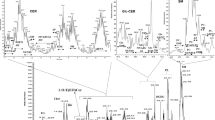Abstract
Factorialized correlation analysis is proposed as a method for predicting the coordination of multiple enzyme pathways. The approach can be used potentially to find new relationships and to predict relationships that have been established in other tissues. However, careful tracer studies are needed to verify the cause-and-effect relationships between precursor and products. In this study, guinea pigs that were chronically treated with an anionic, a nonionic and a cationic surfactant passed through an irritation stage to a clinical state that appeared normal. The method was used to examine binary coordination of lipid biosynthesis in the epidermis by using a factorialized table of regression coefficients. Coordinated lipid relationships that have been reported in other tissues were predicted between sphingomyelin and cholesterol, as well as between phosphatidylcholine, phosphatidylserine and phosphatidylethanolamine. A new inverse relationship was found between triglycerides and both sphingomyelin and cholesterol, using this method. These data are discussed with respect to a membrane fluidization model for the accommodated state.
Similar content being viewed by others
Abbreviations
- L-1:
-
laureth-1
- LTC:
-
laurtrimonium chloride
- SLS:
-
sodium lauryl sulfate
- AEC:
-
automatic external standard channels ratio
- TLC:
-
thin layer chromatograph(ic,y)
References
Adams, R.M. (1969) inOccupational Contact Dermatitis, p. 6, Lippencott Publishers, New York, NY.
Mathias, C.G.T., and Maibach, H.I. (1978)Clin. Toxicol. 13, 333–346.
Opdyke, D.L., and Burnett, C.M. (1965)Toilet Goods Assoc. 44, 3–4.
Stanley, J., Foidart, J., Murray, J., Martin, G., and Katz, S. (1980)J. Invest. Dermatol. 74, 54–58.
Bligh, E., and Dyer, W. (1959)Can. J. Biochem. Physiol. 37, 911–917.
Shand, J.H., and Noble, R.C. (1980)Anal. Biochem. 101, 427–434.
Snyder, F., and Moehl, A. (1969)Anal. Biochem. 28, 503–509.
Radin, N.S., Deshmukh, G.D., Selvam, R., and Hospattankar, A.V. (1982)Biochim. Biophys. Acta 713, 474–478.
Nobel, R.C., Shand, J.H., and Wagstaff, H.F. (1982)Anal. Biochem. 122, 47–51.
Nobel, R.C., Shand, J.H., and West, I.G. (1982)LKB Instr. J. 29, 1–7.
Selvam, R., and Radin, N.S. (1981)Anal. Biochem. 112, 338–345.
McOsker, D.E., and Beck, L.W. (1967)J. Invest. Dermatol. 48, 372–383.
Patton, S. (1970)J. Theor. Biol. 29, 489–491.
Rouser, G., Kritchevsky, G., and Yamamoto, A. (1972)Adv. Lipid Res. 10, 261–360.
Barenholz, Y. (1984) inPhysiology of Membrane Fluidity (Shinitzky, M., ed.) Vol. I, pp. 131–173, CRC Press, Boca Raton, FL.
Frederickson, D.S., and Sloan, H.R. (1972) inThe Metabolic Basis of Inherited Disease (Frederickson, D.S., ed.) 3rd ed., pp. 7813–807, McGraw-Hill, New York, NY.
Sakuragawa, N., Sakuragawa, M., Kuwabara, T., Pentchev, P.G., Barranger, J.A., and Brady, R.O. (1977)Science 196, 317–319.
Elias, P.M., Lampe, M.A., Chung, J., and Williams, M.L. (1963)Lab. Invest. 48, 565–577.
Hirata, F., and Axelrod, J. (1978)Nature 275, 219–220.
Hirata, F., and Axelrod, J. (1978)Proc. Natl. Acad. Sci. USA 75, 2348–2352.
Borkenhagen, L.F., Kennedy, E.P., and Fielding, L. (1961)J. Biol. Chem. 236, PC28-PC30.
Hubscher, G. (1961)Biochim. Biophys. Acta 57, 555–561.
Dennis, E.A., and Kennedy, E.P. (1972)J. Lipid Res. 13, 263–267.
Bjerve, K.S. (1973)Biochim. Biophys. Acta 296, 549–562.
Suskind, R.R. (1977)Environ. Health Perspec. 20, 27–37.
Hill, M.W., and Bangham, A.D. (1975)Adv. Exp. Med. Biol. 59, 1–9.
Chin, J.H., Parsons, L.M., and Goldstein, D.B. (1978)Biochim. Biophys. Acta 513, 358–363.
Chin, J.H., and Goldstein, D.B. (1984)Lipids 19, 929–935.
Shinitzky, M., and Inbar, M. (1974)J. Mol. Biol 85, 603–615.
Author information
Authors and Affiliations
About this article
Cite this article
Ando, H.Y., Gazdick, G.G.G., Sugita, E.T. et al. Predicting coordinated lipid biosynthesis: Application to the surfactant-accommodated epidermis. Lipids 23, 1073–1078 (1988). https://doi.org/10.1007/BF02535655
Received:
Accepted:
Issue Date:
DOI: https://doi.org/10.1007/BF02535655




